|
FAQs about Identification of Faviid
Corals 3
Related
Articles: Faviid Corals,
Related FAQs: Faviid Identification 1, Faviid ID 2, Faviid
ID 4 &, Faviids 1, Faviids 2, Faviids 3, Faviid Behavior, Faviid Compatibility, Faviid Selection, Faviid Systems, Faviid Feeding, Faviid Disease, Faviid Reproduction/Propagation,
Stony/True Coral, Coral System Set-Up, Coral System Lighting, Stony Coral Identification, Stony Coral Selection, Coral Placement, Foods/Feeding/Nutrition, Disease/Health, Propagation, Growing Reef Corals, Stony
Coral Behavior, |
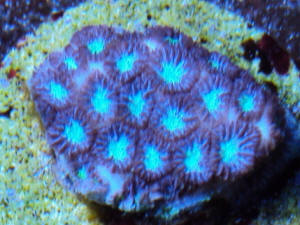
|
|
Coral identification 12/19/19
I need your help about this coral identification
<Appears to be a Faviid of some sort (Family Faviidae); may be able to guess
further to genus if you can give me an idea of the diameter of the polyps (in
mm.). Bob Fenner>
|
 |
|
LPS Identification 1/6/15
Good Evening The fine crew at WWM,I was wondering if you could help me identify
the coral in the middle of the picture. I was thinking some type of Favia or
Favites, but now I'm not so sure.
<Maybe.... or a Caulastrea species?>
The light green polyps on top are the same as the rest of the coral. Is it
common for younger polyps to have tentacles in the Favites or Favia Venus?
<Genus? Yes>
Any help would be greatly appreciated. Have a great night! Jason
<And you, Bob Fenner>
|
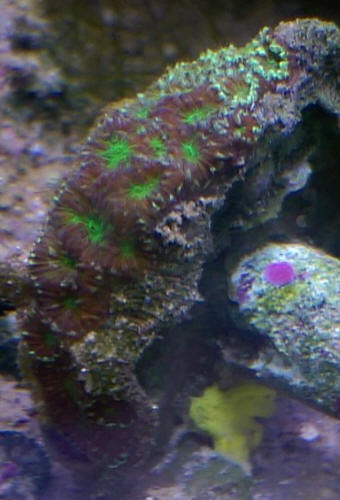 |
|
Re: LPS Identification 1/8/16
Thanks Bob for the speedy reply! I'll check into the Genus Caulastrea, not sure
that is spelled right, but I believe they are not encrusting and what I have is.
<Some species are... Do you have any of Veron's works?>
Either way I believe the care is roughly the same so maybe exact species isn't
necessary.
<Yes; tis so>
I have another question regarding water changes, currently I do 3 gallon changes
daily on a 20 gallon plus 15 gallon sump. I have noticed that I'm starting to
have brown diatoms growing on the glass, do you think that will subside in time?
<Mmm; possibly... a matter of balances... best to do what you can to increase
RedOx, improve skimming, use (prudent) of chem. filter media; poss. use of
competitors>
I know its related to the water changes. My source water is the primo water
refills at Wal-Mart. The water there is suppose to go through a sediment filter,
carbon block, to, and finally UV. I want to get an rodi unit but that will have
to wait. If it wont go away on its own then what is the best way to remove
silicates from the water.
<Ahh; do please search/see/read on WWM Re. Am out diving in Florida and hard to
look u>
Thanks in advance for helping me with my questions and have a great night. Jason
<Thank you. Bob Fenner>
Re: LPS Identification 1/9/16
Bob, As always thanks for your time, effort, and help. I will definitely check
on the 3 volume compendium, and thanks for the website. Jason
<Am very sure you will enjoy and gain by its perusal. A personal note; a dear
(and unfortunately departed) friend, John Jackson, of Odyssey Publishing was
very good friends w/ J.E.N (Charlie) Veron... in fact brought him out to the
MACNA... was it in Boston? Years ago. I'd pre-purchased a set of this work, and
John gifted me one of the hundred leather bound ones... I gave away the first,
and yes; have written in the limited ones... as is my habit. BobF>
|
Diploastrea Feeding, Centropyge Suitability
3/2/15
Dear Bob (or other Crew),
<W.K.>
I was wondering if you might be able to provide your opinion on a couple
of questions I have.
<Let's see>
1) I have a Diploastrea, which has been in the tank for 2 months and is
showing signs of what I assume is normal behaviour (polyp
retraction/extension, light-sensitivity, eating behaviours, growth/polyp
budding). However, I have also occasionally noticed it apparently
"eating" fragments of various macroalgae pieces that have been floating
around my tank.
<Mmm; most such corals... Faviid... now in a sep. family Diploastreidae?
Are nocturnal feeders... on zooplankton principally... can learn, do
learn to open during daylight... not cultured as yet as far as I'm
aware>
When doing this, the polyp involved appears to hold the algae in its
mouth (at the centre of the polyp) in much the same way as it would do
to its normal food when I target feed, and this hold appears quite
strong as the local current can exceed 15cm/s. I have always assumed
such corals are carnivorous, and I have never directly observed any
polyp completely ingesting an algal fragment, so it could simply be a
case of mistaken identity,
<Sure... there can be chemical cues on what appears to be "solely" algae
et al.; that my contain other life>
and the algae is spat out later on, but polyps can sometimes hold onto
the algae for at least an hour, which strikes me as rather deliberate
behaviour. Is this normal behaviour, do you think, or could my coral be
starving and thus desperate to eat
anything it can get its mouths on?
<I don't consider this behavior aberrant... i.e., I'd list it as normal>
2) I previously wrote to you about stocking my tank with a fish, and
after hesitating, reading and re-reading what I could find on the
subject, I think I have decided on a single Centropyge argi or
aurantonotus for my tank. That said, I would like to run my proposal
past you one final time, just to make sure my choice is actually
suitable. Tank details as follows (apologies if some of it is
superfluous):
<Ok>
My system is a stony coral reef tank of volume 240L (60gal) with a 0.5in
SSB, and an upstream 80L refugium with a 4in DSB. The main tank (where
the fish will reside) has a footprint of 48in*18in. The main tank
contains about 25L of LR (estimated by measuring displacement), and I
use a Tunze 9006 skimmer for nutrient export, although at 30% efficiency
at present. I maintain tank temperature between 26 and 28 deg. C and
water chemistry suitable for Scleractinians; from the fish's point of
view, this is salinity 35-36ppt, nitrates consistently undetectable
<Cnidarians DO need some NO3>
and phosphates less than 0.03ppm (Salifert kits). Flow in the tank is
somewhat chaotic with a total turnover exceeding 12000L/hr (i.e. 50x)
provided by powerheads, and lighting is a DIY system sufficiently bright
to support Acropora. The other intentional tank inhabitants are six
Lysmata spp. shrimp,
<Keep your eyes on these... may be too many, walking over your stony
corals>
various snails and a number of Scleractinians (Pocilloporids,
Acroporids, Diploastrea and an unidentified, possibly Agariciid), and
there will be no other fishes at any time apart from the dwarf angel. I
have attempted to arrange the rockwork loosely, with caves and a couple
of swim-throughs, but I didn't do it that well,
<Can be re-done; next time you get a hankering>
as most of these are quite cramped and I think will only just admit an
adult-sized fish. There is, however, space to swim at the back and sides
of the rock mounds. The LR itself was cured on purchase and 3-5 months
old; it appears established with a fair amount of macroalgae (at least
20 species of which I hope at least some is edible) and a moderate
coverage of sponges in the sheltered areas. The refugium (5 months old)
also appears to be producing a fair number of Mysid shrimp in addition
to other things and rocks placed in it will grow sponges in a number of
weeks, so I can swap them out to provide extra grazing if necessary. I
intend to feed the fish with what I feed my corals (DIY recipe,
blended/frozen and mostly meaty = 30% fresh oysters, 30% other
shellfish, 15% D-D clam/filter feeder powder, 10% reconstituted algae,
remainder liquid vitamin mix), a pellet food (probably ON Formula Two)
and dried algae sheets. I do not have a quarantine setup (I'm sorry to
say), but plan to dip the fish with freshwater/Methylene blue before
introduction.
<Sounds good>
The reason why I would like a fish is primarily to provide some
pollution to help feed my corals (I still can't increase nutrient levels
above barely detectable despite regular feeding) and to graze some of my
macroalgae, which I have only partially controlled in anticipation of it
being a necessary food source. I expect the fish will also be
interesting to observe, but to be brutally honest, I am more interested
in corals/non-vertebrate life than fish, so this is only a secondary
consideration. I understand that there is a risk with dwarf angels
nipping or even consuming my corals, but I am willing to accept this
(and to remove the fish if destructive) assuming the tank is otherwise
suitable. The only negative thing I can think of is that the tank is on
the smaller end of the acceptable range for small Centropyge species.
<Yes; the smaller-est>
So in total, do you think my tank is a suitable habitat for a C. argi or
aurantonotus (or if not, any other dwarf angel species)?
<Yes>
Also, do you think it is reasonable to get one of these fishes mainly
for the purposes of converting food/algae to waste in an otherwise
low-nutrient reef tank?
<And yes>
If so, is my feeding plan sufficiently diverse for a dwarf angel?
<I do>
Many thanks for your assistance,
Wesley
<A pleasure to share w/ you. Bob Fenner>
Re: Diploastrea Feeding 3/3/15
Dear Bob,
On 2015-03-02 15:44, WetWebMedia Crew wrote:
> I was wondering if you might be able to provide your opinion on a
> couple of questions I have.
> <Let's see>
Thanks for responding so fast (as usual).
<Welcome>
> <Mmm; most such corals... Faviid... now in a sep. family
> Diploastreidae?
> Are nocturnal feeders... on zooplankton principally... can learn, do
> learn
> to open during daylight... not cultured as yet as far as I'm aware>
Heh. I didn't know about the reclassification of Diploastrea; thanks for letting
me know about it. According to what I can find, it seems that Diploastraeidae
was resurrected in 2012 in the following paper (Note: "Diploastreidae" without
the extra "a" is used everywhere else including WoRMS, but it is not the
spelling used by the following reference and by the authors in their works):
Budd A.F. et al. 2012. Taxonomic classification of the reef coral family
Mussidae (Cnidaria: Anthozoa: Scleractinia). Zoological Journal of the Linnean
Society 166(3):465-529
(http://onlinelibrary.wiley.com/enhanced/doi/10.1111/j.1096-3642.2012.00855.x/)
According to molecular analysis conducted in 2008 by this group, most
traditional Scleractinian family classifications are not clades (i.e. the corals
within such families are not all descended from a common ancestor) and so a lot
of genera are likely to end up being reclassified. Diploastrea heliopora is
apparently genetically distinct and diverged early on in evolutionary terms from
most other Faviids.
Along with analysis of various morphological characteristics suggesting that the
skeletal structure is also quite distinct from other Faviids, there is strong
evidence that this particular genus deserves its own family, thus the suggestion
of Diploastraeidae. Apparently, the closest relative to these corals based on
molecular analysis is Montastrea cavernosa, which is suggested to be the sole
member of its genus and also in a separate family, Montastraeidae (all other
Montastrea species
have been moved out to different genera).
I suppose I should say that this sort of reclassification is not necessarily
correct either, given our lack of understanding of both horizontal gene transfer
(i.e. genetic material passing between otherwise apparently unrelated corals)
and the assumptions we make about mutations accumulating in genomes over time
and the mathematical models we use to construct such evolutionary trees, but it
seems very interesting nonetheless.
<I follow your gist; and agree w/ you>
As for culturing, I had assumed my Diploastrea was propagated artificially,
based on the assurances of my LFS, but I guess you might be right that it could
be a frag originally broken from a larger wild colony and then rehabilitated in
a tank before sale.
<Have never seen this genus cultured; Faviids period... not easy to frag and
slow growers; poor sellers>
It appears at the moment to be growing at a rate of 4-8mm/yr so I guess I might
be able to propagate it myself if it gets big enough. Polyps tend only to open
after lights off (sweeper tentacles only come out in absolute pitch dark),
<Ah yes; in the hundreds of times I've seen underwater... the same>
and often retract if a bright light (e.g. a torch) is shone on them. The
exception is when target fed, when the coral is very quick to gorge itself on
whatever is stuck to its mucus net.
> I have always assumed such corals are carnivorous, and I have never
> directly observed
> any polyp completely ingesting an algal fragment, so it could simply be
> a case of mistaken identity,
> <Sure... there can be chemical cues on what appears to be "solely"
> algae et
> al.; that my contain other life>
Do you know, I had a D'oh moment shortly after I sent the email when I realised
this could be the answer: I think you might very well be right. Perhaps my coral
is enjoying the equivalent of a lollipop, sucking off whatever is on the surface
and then discarding the algal "stick" later on.
> My system is a stony coral reef tank ... nitrates consistently
> undetectable
> <Cnidarians DO need some NO3>
Heh; I know. I'm trying, honest, but the amount of food I am putting in there
scares me. Even when the tank was a moderately stocked FW community tank, I
don't think I ever fed it with nearly as much food as I do now. I guess it just
goes to show how "reef" tanks set up like this can have a large capacity to
store and process biomatter and waste, and that if you provide food/nutrients of
whatever form to excess, there is likely to be some organism around that will
take advantage of it. I'm hoping the angel will help reduce some of the corals'
competitors in the tank through grazing them and pooping them out as nutrients,
but we'll see.
> The other intentional tank inhabitants are six
> Lysmata spp. shrimp,
> <Keep your eyes on these... may be too many, walking over your stony
> corals>
Hm, yes. Now that you mention it, the peppermints do particularly graze on my
Pocilloporas although they have never actually killed any polyps as far as I can
see. I'll certainly bear them in mind if my corals start to look unhappy.
> So in total, do you think my tank is a suitable habitat for a C. argi
> or
> aurantonotus (or if not, any other dwarf angel species)?
> <Yes>
> Also, do you
> think it is reasonable to get one of these fishes mainly for the
> purposes of converting food/algae to waste in an otherwise low-nutrient
> reef tank?
> <And yes>
> If so, is my feeding plan sufficiently diverse for a dwarf
> angel?
> <I do>
Thanks for your feedback.
Wesley
<And you for your input. Cheers, BobF>
Coral ID 3/4/12
Please ID, thanks.
<Paul, easily found on our site, please learn to use the
search tool. Your corals appear to be Faviids,
Caulastrea. See, scroll down here.
http://www.wetwebmedia.com/faviidae.htm
James (Salty Dog)>
|
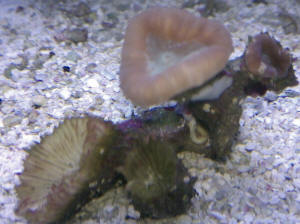 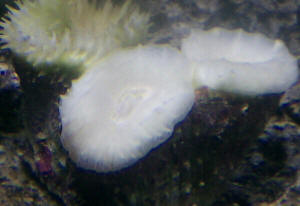
|
|
Re Hitchhiker ID 3/5/12
I of course use the search tool on your website, it's the
only reason I haven't asked more questions. If you
prefer I can seek my answers elsewhere, but I don't trust
other sources half as much.
<Was not aware you have searched the site.>
So, hopefully you'll indulge me once more, and only
because hours of searching your site and others have not revealed
what these creatures are. I thought they were sponges, but
they glow slightly in the center of the discs at the top.
They are also pushed slightly in the current. And I have
not seen any tentacles.
<I wish you would have replied to the original thread.
If I recall correctly, the original thread was coral ID,
Faviids. If you are referring to the 8-10 brownish polyps
in this attachment, they appear to be solitary
Zoanthids. There are three growth forms of
Zoanthids, solitary, connected (polyps joined by the stolon), or
massive (polyps embedded in coenenchyme). I cannot blow the
picture up very much without excessive pixelization. A
close up may provide a more accurate ID. If there is
chemical allelopathy going on in your system, the tentacles may
not fully extend.
Bob may also comment on the ID here.>
Thanks for the answers.
<You're welcome. James (Salty Dog)>
|
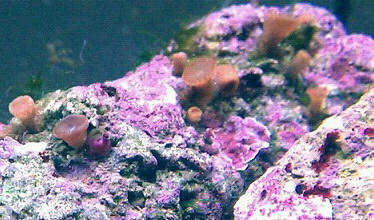 |
Re Hitchhiker ID 3/5/12
Thank you,
<Welcome>
it's exciting to get new creatures without knowing it,
WWM is a great site full of info which I consume daily. These
brown guys are different from the original thread, 'tis why I
didn't respond to that thread.
<I see but you could have, was still coral ID.>
I tried feeding them Mysis shrimp and they ate the shrimp! I
have been staring at them quite awhile today, and I think a saw
very tiny tentacles less then 1mm... and I also noticed when they
close up they look like baseball bats with a hole in the top.
Do you think the ones that stay closed most or all of the time are
in decline (there are only a few small ones staying closed)?
<Mmm, all depends on other Cnidarians present as I mentioned
before, may be some allelopathy going on....other Zoas, mushrooms,
etc. May be lighting, too strong, not strong enough, too much
water flow. Best to search/read Zoanthids.>
Thanks again.
<You're welcome. James (Salty Dog)> |
Live Rock Acquired
Coral 2/12/12
Greetings, I purchased a small Live Rock to which an assortment of
life was attached. This life included 3-4 types of worm, a couple
of glass anemone, a clam, two stalks of what I assume to be
seaweed, and 4-5 small groups of coral. My main question has to do
with the coral and it's ID.
It has small brown tubular stalks with little vertical ridges. It
also has small, translucent "fingers" that stick out of
the top of the coral.
The only picture I found on the website that looked right is found
here:
http://wetwebmedia.com/ca/volume_2/cav2i3/Live_Rock/live_rock.htm
<The first pic... near top, center? Looks to be some
sort/species of Faviid...> |
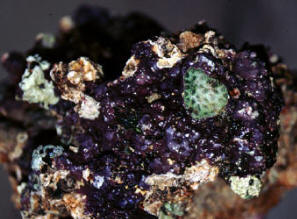 |
|
I would also like to know
how to care for this coral,
<... read here: http://www.wetwebmedia.com/faviidsysfaqs.htm
and the linked files above>
and if the t5 24 watt 1 white and 1 blue lights are enough with a
28 gallon euro tank (about 19 inches tall, so right around 16
inches to the sand).
<Apparently so>
Also, while my tank is cycling, is there anything I should be
doing to care for the other animals I acquired through the live
rock?
<... Read here: http://www.wetwebmedia.com/lrcurefaq8.htm
and the linked files above, part. "Water
Quality">
Thank you.
<Welcome. Bob Fenner>
Re: Live Rock Acquired Coral 2/12/12
Yes, forgive me, the coral picture found in the "Live
Rock" article is the second picture you see scrolling down
the web page.
<Oh... this appears to be another Faviid... of the genus
Cladacora. You can search/read re its husbandry on the Net,
books>
Also, I wanted to ask about what I think may be a sponge I got
with the live rock. It is spongy to the touch, and has what looks
like green plant stems coming up from it.
It's the size of a peanut and a dark blackish-green color.
Any thoughts are appreciated. Thank you.
<... posted, gone over and over on WWM. Do learn to/use the
search tool, indices. BobF>
|
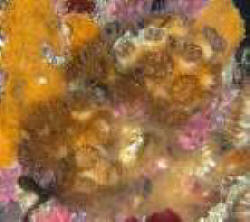 cropped,
expanded cropped,
expanded |
|
Lighting and IDs 1/27/12
Hi Crew,
<Hello Rick>
I am after your opinion about my Lighting - currently I have 3 x
120W banks of LEDs as in the picture attached (LED Current).
The tank seems happy enough although it has only been set up for
a few months. All the stock in it are out of several nanos
I've had scattered around the house for about 5 years.
I've very good coralline growth in the new tank and bulk live
Pods and Mysis shrimp due to the 300Lt fishless sump.
<Nice.>
The tank contains a full reef with Live Rock, Fish, SPS and LPS
corals.
The water level from where the lights are mounted to the top of
the aragonite bed is approx 600mm.
I am a bit concerned I've mucked up the ratios of the LED
banks and was after your opinion on light spectrum.
The new banks I'm thinking of building will look like the
picture "LED New"
Can I ask your opinion on the light spectrum and ratios I'm
considering?
<Sure. The 20K LEDs are not much use for growing corals, at
least the corals we commonly keep in our aquaria. I would not
waste the energy on these LEDs but direct it toward the usable
spectrum need by corals (420-700nm). I would not use any LEDs
below 400nm as you are then getting into the UV range which
could/can cause molecular damage to some animals in
your system.>
In addition to the lighting configuration I'm considering , I
am also planning on building 2 x Black Light bars at 18 Watt each
to help fluoresce the tank.
<Would not use this as well as they are well into the UV range
and will be hard on the eyes with extended viewing of your
aquarium. Depending on the intensity, the black light may even
damage your eyes if looking directly at them.
At what Wave length will I be exposing the live stock / bacteria
to dangerous levels of U/V radiation?
<Anything below 400nm. UV is in the range of 10-400nm. Below
10nm is the X-Ray spectrum.
Do you think 360nm would be ok, would the 400nm be just as
effective, or could I go lower?
<I personally would not use anything below 420nm.>
Two more questions regarding an ID. See picture
"ID".
This animal has gotten into my sump obviously through live rock,
it doesn't do any damage (except eating the occasional baby
Bristle Worm}. The animal lays flat on the aragonite and very
quickly closes up as food touches or floats over it. It is an
Omnivore as I've seen it eat anything from bits of algae to
shrimp. It's had a few goes at larger Bristle worms but lets
them go after closing around a portion of them, however, it has
no problem chomping up the babies.
<Appears to be a Rock/Flower Anemone, an Actinia of
some type. Bob may input here with a more accurate
ID.>
The next one is a coral that I haven't found conclusively
what it is, It may be some type of brain but the closest pictures
I can find suggest a moon coral. I'm unsure where to place
it, whether on the aragonite bed or on the live rock. The coral
fluoresces beautifully at night under the moon lights and
exceptionally with a jigged up 360nm LED.
<Appears to be a Faviid species, possibly a Moon
Coral. May want to peruse here.
http://www.wetwebmedia.com/faviididfaqs.htm>
As always your advise is appreciated.
<You're welcome. James (Salty Dog)>
Cheers
Rick (who just got his open water license and is about to dive
the GBR J )
<Lucky you!>
|
|
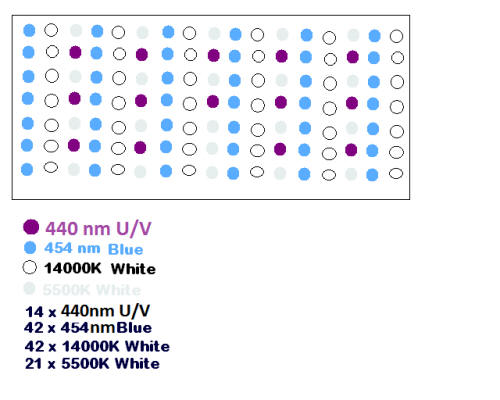
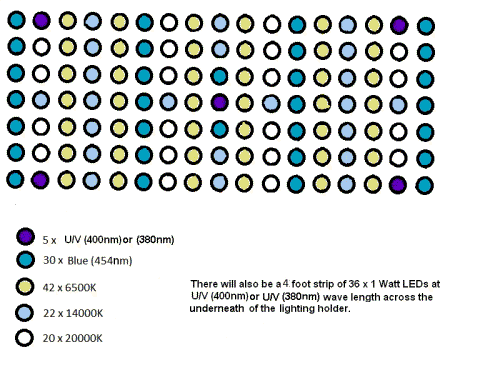
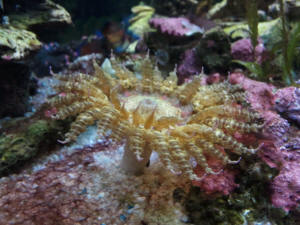 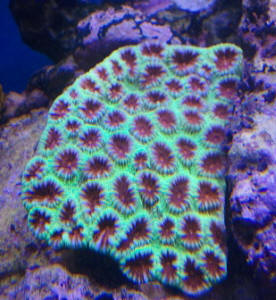
|
|
Is this bubble
algae?/what kind of coral is this? 7/15/11
Hello everyone at WWM,
<Tim>
I got this Zoanthid about 7 weeks ago at my LFS for $5.00. I had
it on a rack and just moved it on to a rock. Is this bubble algae
to the right of it?
<Mmm, yes>
I have never had that type of algae. I have not glued the piece
yet so I can take it out and remove if that is what it is,
don't want it spreading.
<Mmm, see WWM re Valoniaceans>
I also heard that it is easier to remove if the bubbles are
bigger. In the second picture I won this at a frag swap and
forgot to ask what it was.
Is it Favia?
<I do think it is of this genus, yes>
Thanks for your help it is much appreciated.
Tim
<Welcome! Bob Fenner>
|
|
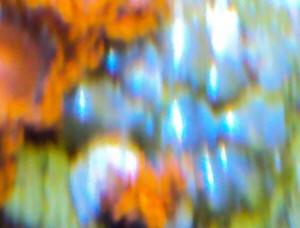 
|
|
|

